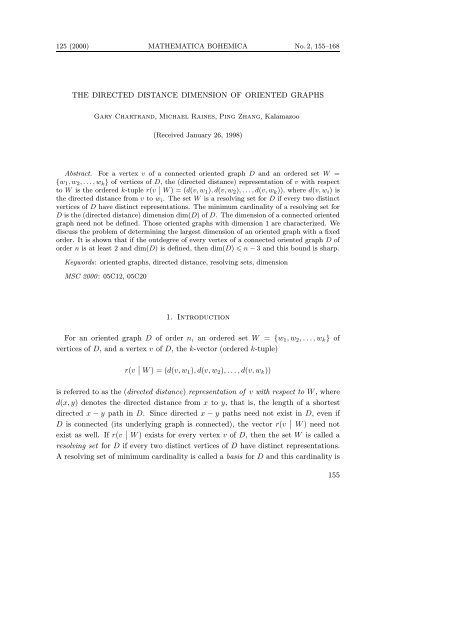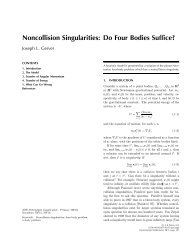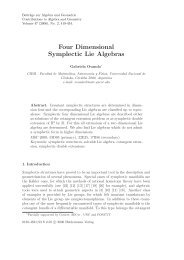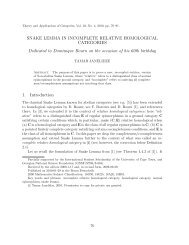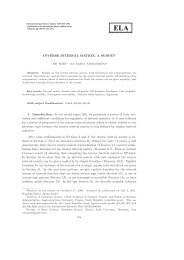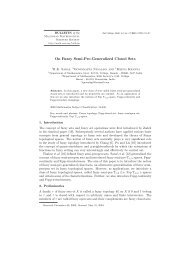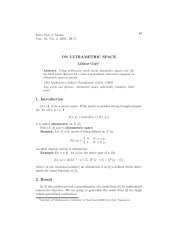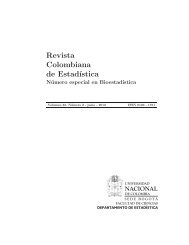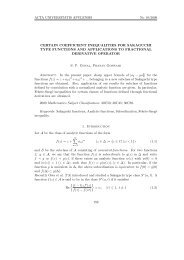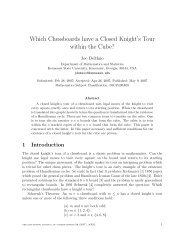THE DIRECTED DISTANCE DIMENSION OF ORIENTED GRAPHS ...
THE DIRECTED DISTANCE DIMENSION OF ORIENTED GRAPHS ...
THE DIRECTED DISTANCE DIMENSION OF ORIENTED GRAPHS ...
Create successful ePaper yourself
Turn your PDF publications into a flip-book with our unique Google optimized e-Paper software.
the (directed distance) dimension dim(D) ofD. Of course, not every oriented graphhas a dimension. An oriented graph of dimension k is also called k-dimensional.To determine whether an ordered set W = {w 1 ,w 2 ,...,w k } of vertices in anoriented graph D is a resolving set, we need only show that the representations of∣the vertices of V (D) − W are distinct since r(w i W ) is the only representationwhose ith coordinate is 0.The directed distance dimension of an oriented graph is a natural analogue ofthe metric dimension of a graph that wasD¡introduced independently by Harary andMelter [2] and Slater [3], [4]. This concept was also investigated in [1] as a result ofstudying a problem in pharmaceutical chemistry.uvxywFigure 1. An oriented graph D with dimension 2In the oriented graph D of Figure 1, let W 1 = {u, v}. The five representationsof the vertices of D with respect to W 1 are r(u ∣ W 1 )=(0, 2), r(v ∣ W 1 )=(1, 0),r(w ∣ W1 )=(2, 1), r(x ∣ W1 )=(2, 1), and r(y ∣ W1 )=(1, 3). Since x and w havethe same representation, W 1 is not a resolving set for D.The five representations of the vertices of D with respect to W 2 = {u, v, w} arer(u ∣ W2 )=(0, 2, 2), r(v ∣ W2 )=(1, 0, 3), r(w ∣ W2 )=(2, 1, 0),r(x ∣ W2 )=(2, 1, 1), r(y ∣ W2 )=(1, 3, 3)Since these five 3-vectors are distinct, W 2 is a resolving set for D. However, W 2is not a basis for D. To see this, let W 3 = {x, y}. Then r(u ∣ W3 ) = (1, 3),r(v ∣ W3 )=(2, 1), r(w ∣ W3 )=(3, 1), r(x ∣ W3 )=(0, 2), and r(y ∣ W3 )=(2, 0),which are distinct as well. So W 3 is a resolving set for D. Since there is no 1-elementresolving set for D, it follows that W 3 is a basis and dim(D) =2.Now let T be the tournament shown in Figure 2. Table 1 gives all 2-elementchoices for W and shows that for each such choice, there exist two equal 2-vectors,thus showing that dim(T ) 3. However, dim(T )=3since{v 1 ,v 3 ,v 6 } is a basisfor T . Figure 3 shows an oriented graph D containing T as an induced subdigraph.The set W = {x, y} is a basis of D, sodim(D) =2. Hencewehavethepossibly156
unexpected property that the 3-dimensional tournament T is an induced subdigraphof the 2-dimensional oriented graph D.v 1v 7T¢v 2v 6v 5 v 4v 3Figure 2. The tournament Tx£v 1v 7v 2u 1 vv 3 u 26v 5 v 4yFigure 3. The digraph DThere is a fundamental question here—one whose answer is not known to us, butone which deserves further study. What is a necessary and sufficient condition forthe dimension of a digraph D to be defined? Certainly, if D is strong, then dim(D) isdefined. Also, if D is connected and contains a vertex such that D − v is strong, thendim(D) is defined. This last statement follows because if od v>0, then V (D) −{v}is a resolving set; while if id v>0, then V (D) is a resolving set. There are numerousother sufficient conditions for dim(D) to be defined.157
Wequivalent vectors{v 1 ,v 2 } r(v 5 | W )=r(v 7 | W )=(1, 2){v 1 ,v 3 } r(v 6 | W )=r(v 7 | W )=(1, 1){v 1 ,v 4 } r(v 5 | W )=r(v 7 | W )=(1, 2){v 1 ,v 5 } r(v 6 | W )=r(v 7 | W )=(1, 2){v 1 ,v 6 } r(v 2 | W )=r(v 3 | W )=(2, 2){v 1 ,v 7 } r(v 5 | W )=r(v 6 | W )=(1, 1){v 2 ,v 3 } r(v 1 | W )=r(v 6 | W )=(1, 1){v 2 ,v 4 } r(v 5 | W )=r(v 7 | W )=(2, 2){v 2 ,v 5 } r(v 1 | W )=r(v 5 | W )=(1, 2){v 2 ,v 6 } r(v 4 | W )=r(v 5 | W )=(2, 1){v 2 ,v 7 } r(v 4 | W )=r(v 5 | W )=(2, 1){v 3 ,v 4 } r(v 1 | W )=r(v 2 | W )=(1, 1){v 3 ,v 5 } r(v 6 | W )=r(v 7 | W )=(1, 2){v 3 ,v 6 } r(v 1 | W )=r(v 2 | W )=(1, 2){v 3 ,v 7 } r(v 2 | W )=r(v 6 | W )=(1, 1){v 4 ,v 5 } r(v 2 | W )=r(v 3 | W )=(1, 1){v 4 ,v 6 } r(v 1 | W )=r(v 2 | W )=(1, 2){v 4 ,v 7 } r(v 1 | W )=r(v 3 | W )=(1, 2){v 5 ,v 6 } r(v 2 | W )=r(v 3 | W )=(1, 2){v 5 ,v 7 } r(v 2 | W )=r(v 4 | W )=(1, 1){v 6 ,v 7 } r(v 4 | W )=r(v 5 | W )=(1, 1)Table 1.2. 1-dimensional oriented graphsIn this section we characterize those oriented graphs having dimension 1. We alsodescribe some properties of bases for 1-dimensional oriented graphs.Theorem 2.1. Let D be a nontrivial oriented graph of order n. Thendim(D) =1if and only if there exists a vertex v in D such that(i) D contains a hamiltonian path P with terminal vertex v such that id D v =1;and(ii) if the hamiltonian path P in (i) is of the formv n−1 ,v n−2 ,...,v 1 ,v,then, for each pair i, j of integers with 1 i
ÈÖÓÓ. Assume that dim(D) = 1. Let W = {v}, v ∈ V (D), be a basisof D. Then the distance d(u, v) fromu to v is defined for each vertex u in Dand the set {d(u, v); u ∈ V (D)} = {0, 1,...,n− 1}. Thus, we may assume thatV (D) ={v, v 1 ,v 2 ,...,v n−1 } where d(v i ,v)=i (1 i n − 1). Clearly, id v =1. Since d(v n−1 ,v) = n − 1, there exists a hamiltonian path in D, namely P :v n−1 ,v n−2 ,...,v 1 ,v, so (i) holds. Furthermore, if there exists a pair i, j of integers(1 i < j n − 1) such that the arc (v j ,v i ) is in D − E(P ), thenj ≠ i +1 andd(v j ,v)=d(v i+1 ,v) (shown in Figure 4). This contradicts the factthat {d(u, v); u ∈ V (D)} consists of n distinct integers, so (ii) holds.v j vv i v i−1 v i−2 v 1 vi+1¤Figure 4.Conversely, assume that there is a vertex v in D such that (i) and (ii) hold.We show that W = {v} is a resolving set of D. Since d(u, v) is defined for eachu ∈ V (D), it suffices to show that the set {d(v i ,v); 1 i n − 1} consists of n − 1distinct integers. Suppose that this is not the case. Then there exist integers i, j(1 ikand k 2 >k. It follows that at least one of these arcs is in D − E(P ), but thisis a contradiction to (ii).□We now present some facts concerning bases in 1-dimensional oriented graphs.Theorem 2.2. Let D be a digraph of order n with dim(D) =1.Furthermore,let v 1 and v 2 be distinct vertices of D with d(v 1 ,v 2 )=2such that both {v 1 } and159
{v 2 } are bases of D. Ifv is a vertex of D such that (v 1 ,v), (v, v 2 ) ∈ E(D), then{v}is also a basis of D.ÈÖÓÓ. To show that {v} is a basis of D, we show that for each u ∈ V (D), thedistance d(u, v) is defined and the set {d(u, v); u ∈ V (D)} consists of n distinctintegers.First notice that id v = 1, for otherwise there exist distinct vertices x and y of Dsuch that d(x, v) =d(y, v) = 1. Since id v 2 = 1, by Theorem 2.1, we haved(x, v 2 )=d(y, v 2 )=d(x, v)+1=2This contradicts the fact that {v 2 } is a basis of D.Furthermore, suppose that there exist vertices u, w in D such that d(u, v) =d(w, v). Since id v =1,eachu − v path contains the arc (v 1 ,v) as its terminalarc, as does each w − v path, sod(u, v 1 )=d(w, v 1 )=d(u, v) − 1Again, this contradicts the fact that {v 1 } is a basis of D.□We now have an immediate consequence of Theorem 2.2.Corollary 2.3. If D is a 1-dimensional oriented graph of order n 3 such that{v} is a basis of D for every vertex v in D, thenD is a directed cycle.ÈÖÓÓ. Let V (D) ={v 1 ,v 2 ,...,v n }. By Theorem 2.2, id v = 1 for every vertexv of D. Moreover,D contains a hamiltonian path P . We can assume thatNext, we show that D contains the cycleP : v n ,v n−1 ,...,v 2 ,v 1C n : v n ,v n−1 ,...,v 2 ,v 1 ,v nSince id v n = 1, there exists a unique vertex v such that (v, v n ) ∈ E(D). If v ≠ v 1 ,then (v i ,v n ) ∈ E(D) forsomei (2 i n − 1). Since {v n } is a basis of D, thereexists a hamiltonian path in D with terminal vertex v n . However, since every vertexhas indegree 1, the only possible path in D with v n as its terminal vertex isP ′ : v n−1 ,v n−2 ,...,v i+1 ,v i ,v nSince P ′ has length n−i, it is not a hamiltonian path. This contradicts the fact that{v n } is a basis. So D contains the cycle C n . Furthermore, since id v =1,D cannotcontain any arc except those in C n .SoD = C n .□160
We can improve Corollary 2.3 slightly.Corollary 2.4. If D is a 1-dimensional oriented graph of order n 3 such that|{v ; {v} is a basis of D}| n − 1then D is a directed cycle.ÈÖÓÓ. Let V (D) ={v, v 1 ,v 2 ,...,v n−1 }. Without loss of generality, we assumethat {v i } is a basis of D for 1 i n − 1. By Corollary 2.3, it suffices to show that{v} is a basis as well.We claim that od v>0. Suppose that this is not the case. Then for each vertexu (≠ v), the distance d(v, u) is not defined, which contradicts the fact that {u} isa basis of D. Hence, there is a vertex x (≠ v) such that (v, x) ∈ E(D). Since {x}is also a basis of D, then by Theorem 2.1(i), D contains a hamiltonian path withterminal vertex x and id x = 1. This implies that there exists a vertex y distinct fromx and v such that (y, v) ∈ E(D). It follows that d(y, x) =2andbyTheorem2.2,{v} is also a basis of D.□The bound in Corollary 2.4 cannot be improved in general. For example, considerthe oriented graph D of order n in Figure 6. Since {v i } is a basis for D for1 i n − 2, dim(D) = 1. However, neither {v n−1 } nor {v n } is a basis D. So|{v ; {v} is a basis of D}| = n − 2andD is not a directed cycle.¦v 3 v 4v 2v 1v nv n−1v n−2Figure 6. An oriented graph with (n − 2) 1-element basesThere is only one 1-dimensional oriented tree of every order.Theorem 2.5. For every oriented tree T , dim(T )=1or dim(T ) is undefined.Furthermore, if dim(T )=1,thenT is a directed hamiltonian path.161
ÈÖÓÓ. There are certainly oriented trees whose dimension is undefined, forexample, any orientation of a star K 1,t ,wheret 3. Now let T be an oriented treewhose dimension is defined. Since T contains no cycles, for every pair x, y of vertices,whenever d(x, y) is defined, d(y, x) is undefined. Thus dim(T )=1.If dim(T ) = 1, then, by Theorem 2.1, T contains a hamiltonian path P and soT = P .□3. On oriented graphs with large dimensionWe have characterized those oriented graphs with dimension 1. But how large canthe dimension of an oriented graph of order n be? In this section, we describe upperbounds for the dimension of a connected oriented graph in terms of lower bounds forthe outdegrees of its vertices. The outdegree of every vertex in the oriented graphD of Figure 7 is 2, yet dim(D) is undefined. Such examples exist regardless of theoutdegrees.D :§Figure 7. The oriented graph DTheorem 3.1. If D is a connected oriented graph of order n 3 with od v 1for all v ∈ V (D) such that dim(D) is defined, then dim(D) n − 2.ÈÖÓÓ. Let D be an oriented graph satisfying the hypothesis of the theorem.Certainly dim(D) n − 1. Assume, to the contrary, that dim(D) =n − 1. LetW = {v 1 ,v 2 ,...,v n−1 } be a basis for D and let V (D) − W = {x}. Since odx 1,assume, without loss of generality, that x is adjacent to v 1 . Also, since odv 1 1,∣we may assume that v 1 is adjacent to v 2 .Sincedim(D) =n − 1, r(v i W −{vi })=r(x ∣ W −{v i })for1 i n − 1. Since x is adjacent to v 1 , it follows that v 2 isadjacent to v 1 , but this contradicts the fact that D is an oriented graph. □We now describe a class of oriented graphs. For k 2, let D k be an orientedgraph with vertex setV (D k )={u, v, w 1 ,w 2 ,...,w k }and let E(D k ) consist of the arc (u, v) andthearcs(v, w j )and(w j ,u)for1 j k.The oriented graph D k is shown in Figure 8. Then D k has order n = k +2 andod v 1 for all v ∈ V (D k ). We claim that dim(D k )=n − 3.162
w kw 2w 1D k :¨uvFigure 8. The oriented graph D k with minimum outdegree 1First we show that dim(D k ) n − 3. Let W = {w 2 ,w 3 ,...,w k },wherethen|W | = n − 3. The distances d(u, w 2 )=2,d(v, w 2 ) = 1, and d(w 1 ,w 2 ) = 3 show thatW is a resolving set for D k and so dim(D k ) n − 3. On the other hand, at leastk − 1 of the vertices w 1 ,w 2 ,...,w k must belong to every resolving set of D k sincethe distance from any two of these vertices to every other vertex of D k is the same.Hence dim(D k ) n − 3 and so dim(D) =n − 3. Of course, this does not show thatsharpness of the bound in Theorem 3.1, except that if D 1 is the directed 3-cycle,then dim(D 1 )=1=n − 2.We can, however, improve the bound in Theorem 3.1 if we require that the outdegreeof every vertex is at least 2.Theorem 3.2. If D is a connected oriented graph of order n 5 with od v 2for all v ∈ V (D) such that dim(D) is defined, then dim(D) n − 3.ÈÖÓÓ. Suppose, to the contrary, that D contains a basis B of cardinality n − 2.Let B = {v 1 ,v 2 ,...,v n−2 },andV (D) −B = {x, y}. For each i (1 i n − 2),B−{v i } is not a resolving set. Hence for each such i, some two of the three verticesx, y, v i have the same representations with respect to B−{v i }. We consider twocases.Case 1: For some i (1 i n − 2), x and y have the same representations withrespect to B−{v i }. Assume, without loss of generality, that x and y have the samerepresentations with respect to W = B−{v n−2 }. Then x and y have the sameout-neighbors in W .Sincex and y have distinct representations with respect to B,exactly one of x and y is adjacent to v n−2 ; for if neither x nor y is adjacent to v n−2 ,then d(x, v n−2 )=d(y, v n−2 ). Therefore, we may assume that y is adjacent to v n−2 .Let W ′ = {v 1 ,v 2 ,...,v n−4 ,v n−2 }. Two of x, y, andv n−3 have the same representationswith respect to W ′ . However, y is adjacent to v n−2 and x is not, so xand y do not have the same representations with respect to W ′ .Thustherearetwopossibilities.163
Subcase 1.1: r(x | W ′ )=r(v n−3 | W ′ ). We claim that x isadjacenttoatmostoneof v 1 ,v 2 ,...,v n−2 . Suppose that this is not the case. Then we can assume withoutloss of generality that x is adjacent to v 1 and v 2 .Thenr(v 1 |B−{v 1 })=r(x |B−{v 1 })orr(v 1 |B−{v 1 })=r(y |B−{v 1 }). Similarly, r(v 2 |B−{v 2 })=r(x |B−{v 2 })or r(v 2 |B−{v 2 })=r(y |B−{v 2 }). Since the out-neighbors of y in W are the sameas the out-neighbors of x in W ,wehavethatv 2 is an out-neighbor of v 1 and that v 1 isan out-neighbor of v 2 .SinceD is an oriented graph, this is impossible, so, as claimed,x isadjacenttoatmostoneofv 1 ,v 2 ,...,v n−2 .Now,sinceodx 2, it follows that xis adjacent to y and exactly one vertex from v 1 ,v 2 ,...,v n−2 ,sayv 1 . However, sincefor 1 i n−3, r(v i |B−{v i })=r(x |B−{v i })orr(v i |B−{v i })=r(y |B−{v i }),it follows that v 1 is an out-neighbor of every vertex in the set {x, y, v 2 ,v 3 ,...,v n−3 },so od v 1 1, which contradicts the assumption that every vertex in D has out-degreeat least 2.Subcase 1.2: r(y | W ′ )=r(v n−3 | W ′ ). We first suppose that x is adjacent tosome vertex in W ′ ,sayv 1 . Because of the assumptions in Case 1 and Subcase 1.2,it follows that y and v n−3 are also adjacent to v 1 . However, since for 2 i n − 3,r(v i |B−{v i })=r(x |B−{v i })orr(v i |B−{v i })=r(y |B−{v i }), it follows that v 1is an out-neighbor of every vertex in the set {x, y, v 2 ,v 3 ,...,v n−3 ,v n−2 },soodv 1 =0,which is a contradiction. Therefore, x is not adjacent to any of v 1 ,v 2 ,...,v n−4 ,v n−2 .Thus, since od x 2, it follows that x must be adjacent to both y and v n−3 . Buty is adjacent to v n−3 as well, because x and y have the same representations withrespect to W . Since x is not adjacent to any of v 1 ,v 2 ,...,v n−4 , it follows that yis not adjacent to any of v 1 ,v 2 ,...,v n−4 . Now r(y | W ′ )=r(v n−3 | W ′ ), so itfollows that v n−3 is not adjacent to any of v 1 ,v 2 ,...,v n−4 . All of this implies thatod v n−3 = 1, which is a contradiction.Case 2: For every i (1 i n − 2), x and y have distinct representations withrespect to B−{v i }. We next prove that every vertex of B is an out-neighbor ofx or y but at most one vertex of B is an out-neighbor of both x and y. To provethis, we first show that among the out-neighbors y 1 ,y 2 ,...,y k of y in B, atmostone y i has the same representation as y with respect to B−{y i }. Suppose thatthis is not the case. Then we may assume that r(y 1 |B−{y 1 })=r(y |B−{y 1 })and that r(y 2 |B−{y 2 })=r(y |B−{y 2 }). The first equality tells us that y 2 isan out-neighbor of y 1 and the second equality tells us that y 1 is an out-neighbor ofy 2 , contradicting the fact that D is an oriented graph. Similarly, among the outneighborsx 1 ,x 2 ,...,x l of x in B, atmostonex j has the same representation as xwith respect to B−{x j }.Next, we show that for each i (1 i n−2), at least one of x and y is adjacent tov i . This follows from the fact that if neither x nor y is adjacent to v i ,thennoother164
vertex v j from B−{v i } can be adjacent to v i since r(v j |B−{v j })=r(x |B−{v j })or r(v j |B−{v j })=r(y |B−{v j }). Thus id v i = 0, which is impossible since d(z,v i )must be defined for all z ∈ V (D). Finally, x and y are simultaneously adjacent toat most one vertex v i (1 i n − 2), for if v a and v b are distinct out-neighbors ofboth x and y, thenv a and v b are out-neighbors of each other, which is impossible.This creates a natural partition of the vertices of B into either two or three subsets,depending on whether there exists a vertex to which x and y are simultaneouslyadjacent. We now consider these two subcases.Subcase 2.1: There exists a unique common out-neighbor of x and y.We assume, without loss of generality, that v n−2 is an out-neighbor of both xand y. Furthermore, we can assume, without loss of generality, that the set X ={v 1 ,v 2 ,...,v k } consists of the out-neighbors of x and not y, and that the set Y ={v k+1 ,v k+2 ,...,v n−3 } consists of the out-neighbors of y and not x. We furtherassume, without loss of generality, that the representations of y and v n−2 with respectto B−{v n−2 } are the same. Therefore, there is no vertex in v j ∈ Y for which therepresentations of y and v j with respect to B−{v j } are the same. Therefore, forevery v j ∈ Y , the representations of x and v j with respect to B−{v j } are the same.Since x is adjacent to every vertex in X, every vertex in Y is adjacent to everyvertex in X ∪{v n−2 }. Now, there is at most one v i ∈ X for which the representationsof x and v i are the same with respect to B−{v i }. Therefore, if |X| 2, there existsat least one vertex v i ∈ X for which the representations of y and v i with respect toB−{v i } are the same. Hence, such a vertex v i is adjacent to every vertex in Y , butthis implies that D is not an oriented graph since for any v j ∈ Y , there is an arcfrom v i to v j and an arc from v j to v i . Therefore, |X| 1. But if |X| =1,thenv 1is the only vertex that could possibly be an out-neighbor of v n−2 . This contradictsthe assumption that the out-degree of every vertex in D is at least 2, so |X| =0. Wehave already seen that every vertex in Y ∪{x} is adjacent to vertex v n−2 ,soevenif|X| =0,wehavethatodv n−2 = 0, which cannot occur.Subcase 2.2: No vertex is a common out-neighbor of x and y.We assume, without loss of generality, that the set X = {v 1 ,v 2 ,...,v k } consistsof the out-neighbors of x and not y, and that the set Y = {v k+1 ,v k+2 ,...,v n−2 }consists of the out-neighbors of y and not x. Recall that there is at most one v i ∈ Xsuch that the representations of v i and x with respect to B−{v i } are equal and atmost one v j ∈ Y such that the representations of v j and y with respect to B−{v j }are equal. This produces three possibilities to consider.Subcase 2.2.1: For every v i ∈ X and v j ∈ Y , the representations of v i and y withrespect to B−{v i } are the same and the representations of v j and x with respect to165
B−{v j } are the same. Then every vertex in Y is adjacent to every vertex in X,and every vertex in X is adjacent to every vertex in Y . This contradicts the factthat D is an oriented graph as long as X and Y are both nonempty. However, if Xor Y is empty, then od x 1orody 1, respectively, which is a contradiction.Subcase 2.2.2: There is exactly one v i ∈ X for which the representations of v iand x with respect to B−{v i } are equal and there is no v j ∈ Y for which v j and yhave the same representations with respect to B−{v j }. (Note that this subcase issymmetric to the case when there is exactly one v j ∈ Y for which the representationsof v j and y with respect to B−{v j } are equal and for which there is no v i ∈ X suchthat v i and x have the same representations with respect to B−{v i }.) Now everyvertex in Y has the same out-neighbors as x, namely the vertices in the set X. SoifY ≠ ∅, then every vertex in Y is adjacent to every vertex in X. Furthermore, everyvertex in X −{v i } has the same out-neighbors as y. Soif|X| 2, then there is atleast one vertex in X which is adjacent to every vertex in Y . But this produces acontradiction since D is an oriented graph. Note that if Y = ∅, theny is adjacent toat most one vertex, namely x, and this is a contradiction.Assume now that |X| 1(so|Y | 2). If |X| =1,thenv i = v 1 and since everyvertex in Y is adjacent to v i ,thevertexv i is adjacent to no vertex except possiblyy. Hence, od v i 1, which is a contradiction. If X = ∅, thenx has no out-neighborsexcept possibly for y, but this contradicts the assumption that the out-degree of xis at least 2.Subcase 2.2.3: There exists exactly one v i ∈ X for which the representations of v iand x with respect to B−{v i } are the same and exactly one v j ∈ Y for which therepresentations of v j and y with respect to B−{v j } are the same. First, supposethat |X| 2and|Y | 2. Then there exists at least one vertex v ∈ X for whichthe representations of v and y with respect to B−{v} are the same. Therefore, v isadjacent to every vertex in Y . Similarly, there is at least one vertex w ∈ Y for whichthe representations of w and x with respect to B−{w} are the same. Therefore, wis adjacent to every vertex in X. However, since v ∈ X and w ∈ Y , it follows thatv is adjacent to w and w is adjacent to v. This contradicts the fact that D is anoriented graph.Next suppose that |X| =1,that|Y | 2, and that X = {v 1 }. Then the outneighborsof x are y and v 1 . Furthermore, v 1 is an out-neighbor of every vertex inY −{v j }. The only possible out-neighbors of v 1 are y and v j . However, if v i isadjacent to v j ,thenx is adjacent to v j , which contradicts the fact that v j /∈ X.Therefore, od v i 1, contradicting the fact that every vertex in D has out-degree atleast 2. The case where |Y | =1and|X| 2 is similar.□166
The sharpness of the bound in Theorem 3.1 is not illustrated by the digraph D kshown in Figure 8 since the outdegrees of most vertices of D k are 1. We can, however,show that the upper bound in Theorem 3.2 is sharp. Let F k be an oriented graphwith vertex setV (F k )={u 1 ,u 2 ,v 1 ,v 2 ,w 1 ,w 2 ,...,w k }and let E(F k ) consist of (1) the arcs (u i ,v j )for1 i, j 2 and (2) the arcs (v i ,w j )and (w j ,u i )for1 i 2and1 j k. The oriented graph F k isshowninFigure9.Then F k has order n = k + 4 and the property that od v 2 for all v ∈ V (F k ). Weclaim that dim(F k )=n − 3.:©w kw 2w 1F ku 2 v 2u 1 v 1Figure 9. The oriented graph F k with minimum outdegree 2First we show that dim(F k ) n − 3. Let W = {u 1 ,v 1 ,w 2 ,w 3 ,...,w k },wherethen |W | = n − 3. The distances d(u 2 ,w 2 )=2,d(v 2 ,w 2 ) = 1, and d(w 1 ,w 2 )=3show that W is a resolving set for F k and so dim(F k ) n − 3. Next we show thatdim(F k ) n − 3. Let W be a resolving set for F k . Certainly at least k − 1ofthevertices w 1 ,w 2 ,...,w k must belong to W since the distance from any two of thesevertices to every other vertex of F k is the same. Moreover, at least one of u 1 andu 2 must belong to W since the distance from u 1 and u 2 every other vertex of F k isthe same. For the same reason, at least one of v 1 and v 2 must belong to W . Hencedim(F k ) n − 3 and so dim(F k )=n − 3.No additional restriction on the outdegrees of the vertices of an oriented graphyields an improved bound, however. Let r 2 be an integer. In the oriented graphof Figure 8, replace u 1 , u 2 by the r vertices u 1 ,u 2 ,..., u r and v 1 , v 2 by the r verticesv 1 ,v 2 ,...,v r and add the appropriate arcs. The resulting oriented graph H k hasod v r for all v ∈ V (H k ), but dim(H k )=n − 3.167
References[1] G. Chartrand, L. Eroh, M. Johnson, O. R. Oellermann: Resolvability in graphs and themetric dimension of a graph. Preprint.[2] F. Harary, R. A. Melter: On the metric dimension of a graph. Ars Combin. 2 (1976),191–195.[3] P.J. Slater: Leaves of trees. Congress. Numer. 14 (1975), 549–559.[4] P.J. Slater: Dominating and reference sets in graphs. J. Math. Phys. Sci. 22 (1988),445–455.Authors’ addresses: Gary Chartrand, Michael Raines, Ping Zhang, Department ofMathematics and Statistics Western Michigan University Kalamazoo, MI 49008, USA, e-mail: zhang@math-stat.wmich.edu.168


